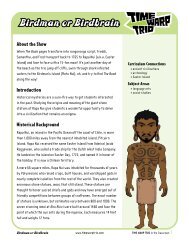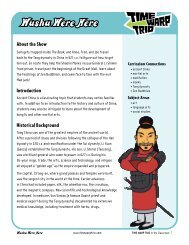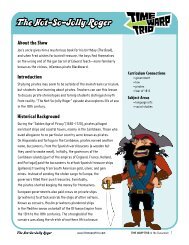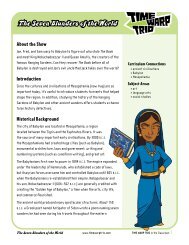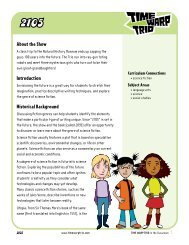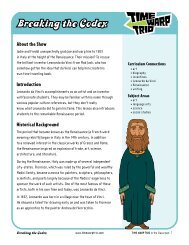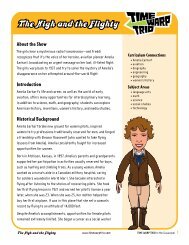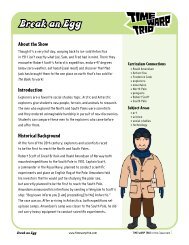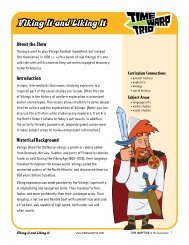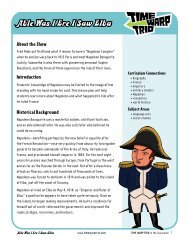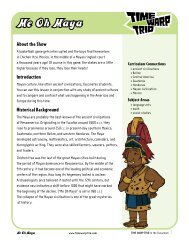You also want an ePaper? Increase the reach of your titles
YUMPU automatically turns print PDFs into web optimized ePapers that Google loves.
<strong>Dude</strong>, Where’s <strong>My</strong> <strong>Karma</strong>?<br />
About the Show<br />
When Joe realizes that he’s slowly disappearing, the kids find<br />
a malfunction in his family tree in The Book and follow it to India<br />
during the Gupta Empire. Sam, Fred, Samantha, and Freddi have<br />
to help Joe’s ancestor Prince Karna win the hand of Princess<br />
Lakshmi to save the entire family line!<br />
Introduction<br />
Studying ancient India will expand students’ knowledge of<br />
world history, geography, culture, and religion. It will also<br />
enhance students’ appreciation of the achievements of<br />
non-Western civilizations.<br />
Historical Background<br />
The Gupta Empire unified a group of smaller kingdoms in<br />
northern India under the rule of a single family from approximately<br />
320 to 500 C.e. While the Gupta rulers mostly stayed out of the<br />
local politics of each kingdom, they instituted a strong military<br />
presence across the region. By some accounts, each village was<br />
protected by a militia-type civil defense squad that consisted of<br />
one elephant, one chariot, three cavalrymen, and five foot-soldiers.<br />
There was a great deal of religious tolerance in Gupta India<br />
as well as significant cultural advances. The Gupta taught<br />
surgery and veterinary training (so they could cure elephants,<br />
who were their primary source of military transportation) at<br />
universities so famous that they attracted students from as<br />
far away as China. The Gupta established a criminal justice<br />
system based on fines rather than capital punishment, and they<br />
offered government grants for artists and writers. The empire<br />
was also a center of scientific exploration. In the 5th century,<br />
<strong>Dude</strong>, Where’s <strong>My</strong> <strong>Karma</strong>? www.timewarptrio.com<br />
Curriculum Connections<br />
• ancient civilizations<br />
• India<br />
Subject Areas<br />
• language arts<br />
• social studies<br />
<strong>Time</strong> <strong>Warp</strong> <strong>Trio</strong> In the Classroom
<strong>Dude</strong>, Where’s <strong>My</strong> <strong>Karma</strong>?<br />
Historical Background continued<br />
the great astronomer and mathematician Aryabhata stated that the earth was round, that it rotated<br />
on its axis, and that it revolved around the sun—centuries before European scientists reached the same<br />
conclusions. Indian mathematicians developed the Arabic numerals (digits one through nine and the zero)<br />
that are used all over the world today, as well as algebra and trigonometry.<br />
Some of the greatest works of Indian poetry and drama were produced under the Guptas. Art was<br />
very much a part of court life. One of the early kings, Samudra Gupta, played the harp and wrote poetry.<br />
Kalidasa, who wrote under the reign of Chandra Gupta II, is considered one of the greatest of Indian<br />
poets and playwrights. Two great epic poems, the Mahabharata and the Ramayana were recorded during<br />
this time. At about 100,000 stanzas, the Mahabharata is the longest poem in world literature.<br />
Indian society was divided into four classes, called varnas in Sanskrit. At the top were the Brahmans,<br />
then the Kshatriyas, the Vaishyas, and finally the Shudras. One popular marriage arrangement in<br />
this period, particularly among the Kshatriya or warrior/aristocrat class, was known as swayamvara.<br />
In Sanskrit, swayam means “self” and vara is alternately translated as “choosing/wanting” and “husband.”<br />
The bride’s family would invite many potential grooms to their house on a certain day and the bride<br />
would choose from among them. Often she first assigned tasks for the suitors to accomplish—a sort of<br />
competition. The winner would be selected as her husband.<br />
<strong>Dude</strong>, Where’s <strong>My</strong> <strong>Karma</strong>?<br />
Want students to get even more<br />
excited about history?<br />
Check out the india adventure for kids at<br />
www.timewarptrio.com/adventures/india/<br />
Put It Back, Jack! and other interactive games to play.<br />
Plentifax 487—the ultimate time traveler’s guide—gives facts about<br />
life in India and more!<br />
Cool Books that kids will love.<br />
www.timewarptrio.com<br />
<strong>Time</strong> <strong>Warp</strong> <strong>Trio</strong> In the Classroom
Activity<br />
1<br />
Book of Knowledge<br />
Give students an opportunity to personalize their<br />
research of india by creating a Book of Knowledge.<br />
Instructions<br />
. Explain that students, individually or in groups, are going to create<br />
a Book of Knowledge about India.<br />
. Discuss what might be included in such a book: descriptions of the<br />
people, Indian art and culture, Indian inventions and innovations, native<br />
plants and animals, historic locations, famous people, etc. Have students<br />
choose one topic to focus on. Decide how many pages per topic each<br />
student should contribute.<br />
. Have students or student groups research their topic. For each fact<br />
or item they find, have them draw or copy a picture representing the<br />
information and then write a description. Have them paste their<br />
information onto a piece of construction paper.<br />
4. Gather the information students have collected and bind the<br />
construction paper into a classroom Book of Knowledge: India.<br />
Students may want to add a cover, write a dedication, and include<br />
a table of contents.<br />
5. In small groups, have students present their contribution to the<br />
Book of Knowledge, choosing sample pages to share with the group.<br />
<strong>Dude</strong>, Where’s <strong>My</strong> <strong>Karma</strong>? www.timewarptrio.com<br />
Objectives<br />
• to demonstrate students’<br />
knowledge of India<br />
• to organize information<br />
in a useful format<br />
Materials<br />
• 6'' x 9'' construction paper<br />
or ledger paper<br />
• smaller rectangles of lined<br />
paper (not needed if students<br />
are using computers)<br />
• glue sticks or rubber cement<br />
• writing supplies<br />
Curriculum Standards<br />
• NCSS<br />
Culture: Students will articulate<br />
the implications of cultural<br />
diversity, as well as cohesion<br />
within and across groups.<br />
• NCTe/ira<br />
Students conduct research<br />
on issues and interests by<br />
generating ideas and questions,<br />
and by posing problems. They<br />
gather, evaluate, and synthesize<br />
data from a variety of sources<br />
(e.g., print and nonprint texts,<br />
artifacts, people, media) to<br />
communicate their discoveries<br />
in ways that suit their purpose<br />
and their audience.<br />
<strong>Time</strong> <strong>Warp</strong> <strong>Trio</strong> In the Classroom
Activity<br />
Game Plan<br />
2<br />
This activity familiarizes students with games from<br />
various cultures.<br />
Instructions<br />
. Remind students that in the show “<strong>Dude</strong>, Where’s <strong>My</strong> <strong>Karma</strong>?” Prince<br />
Mahaloogi and Prince Karna play a game of chess. Sam mentions that<br />
the game was invented in India.<br />
. As a class, brainstorm a list of games—culturally traditional, board or<br />
card games, sports, memory games, etc. Encourage students to think of<br />
a wide variety of games from many cultures, from mancala and gin rummy<br />
to charades, hopscotch, and baseball.<br />
. Organize students into small groups and tell them that each group will<br />
research the origin of a game (by choice or assignment).<br />
4. Have each group first decide on how they will present their information.<br />
They can make a replica of the game, play one round of the game, perform<br />
a short skit about the game’s origins, profile the inventor of the game, etc.<br />
Review the “game plan” of each group.<br />
5. Hold a “Game Day” and have each group share their work. Discuss the<br />
similarities and differences among the games. Let students play each<br />
others’ games, if possible.<br />
<strong>Dude</strong>, Where’s <strong>My</strong> <strong>Karma</strong>? www.timewarptrio.com<br />
Objectives<br />
• to practice research skills<br />
• to work cooperatively<br />
Materials<br />
• writing materials<br />
Curriculum Standards<br />
• NCSS<br />
Culture: Students will articulate<br />
the implications of cultural<br />
diversity, as well as cohesion<br />
within and across groups.<br />
• NCTe/ira<br />
Students conduct research<br />
on issues and interests by<br />
generating ideas and questions,<br />
and by posing problems.<br />
They gather, evaluate, and<br />
synthesize data from a variety<br />
of sources (e.g., print and<br />
non-print texts, artifacts,<br />
people, media) to communicate<br />
their discoveries in ways<br />
that suit their purpose and<br />
their audience.<br />
<strong>Time</strong> <strong>Warp</strong> <strong>Trio</strong> In the Classroom 4
Resources<br />
Recommended Books<br />
For Teachers<br />
Cultural History of india edited<br />
by A.L. Basham. (Oxford University<br />
Press, 1999)<br />
A survey of Indian culture, including<br />
religion, philosophy, literature, art,<br />
architecture, music, and science, as<br />
well as an examination of the impact<br />
of Indian civilization on the world.<br />
early india: From origins to aD<br />
1300 by Romila Thapar. (University<br />
of California Press, 2004)<br />
From its prehistoric beginnings to<br />
the emergence of mighty dynasties,<br />
this is a comprehensive history by<br />
a renowned Indian historian.<br />
The Greenwood encyclopedia of<br />
Daily Life, volume 1 edited by Joyce E.<br />
Salisbury. (Greenwood Press, 2004)<br />
A comprehensive look at the lives<br />
of ordinary people in ancient times—<br />
their clothes, food, culture, customs,<br />
beliefs, etc.<br />
india: a History by John Keay.<br />
(Grove Press, 2001)<br />
A narrative, illustrated history of<br />
India, from its beginnings in 3000 B.C.E.<br />
indian art, rev. ed. by Roy Craven.<br />
(Thames & Hudson, 1997)<br />
The World of Art series. The traditions,<br />
symbolism, and variety of Indian art are<br />
presented and explained.<br />
For Students<br />
Fiction<br />
The Conch Bearer by Chitra Banerjee<br />
Divakaruni. (Simon & Schuster, 2003)<br />
A conch shell with special powers,<br />
a street-wise girl, and an old man with<br />
surprising skills lead Anand to take<br />
a journey far from home.<br />
Jamil’s Clever Cat by Fiona French with<br />
Dick Newby. (Frances Lincoln Ltd., 1998)<br />
Jamil’s cat, Sardul, tricks the Rajah into<br />
allowing his daughter to marry a lowly<br />
weaver in this Bengali folk tale.<br />
Nine animals and the Well by James<br />
Rumford. (Houghton Mifflin, 2003)<br />
This is the cumulative tale of nine<br />
animals’ attempts to find just the right<br />
birthday presents for a young raja-king.<br />
Also traces the origins of numerals<br />
from Arabia to North Africa and India.<br />
rama and the Demon King<br />
by Jessica Souhami. (DK, 1997)<br />
In this ancient tale, Rama is exiled by<br />
his father at the request of his jealous<br />
stepmother. He returns from exile to<br />
become the king.<br />
robi Dobi, The marvelous<br />
adventures of an indian elephant<br />
by Madhur Jaffrey. (Dial Books, 1997)<br />
When the elephant Robi Dobi saves<br />
a small orange animal named Kabbi<br />
Wahabbi, he finds a lifelong friend who<br />
shares adventures with him.<br />
Savitri: a Tale of ancient india<br />
by Aaron Shepard. (Whitman, 1996)<br />
A retelling of a story from The<br />
Mahabharata, in which the king’s<br />
only daughter searches for a perfect<br />
husband. Then she has to convince her<br />
father to let her marry her choice.<br />
<strong>Dude</strong>, Where’s <strong>My</strong> <strong>Karma</strong>? www.timewarptrio.com<br />
Shiva’s Fire by Suzanne Fisher Staples.<br />
(HarperCollins, 2000)<br />
Parvati’s skill as a dancer leads to<br />
a wonderful opportunity to study with<br />
a master of classical Indian dance but<br />
she is not sure if she can leave behind<br />
all that she loves. For older readers.<br />
Tusk and Stone by Malcolm Bosse.<br />
(Front Street, 1995)<br />
Arjun is a member of the Brahman<br />
class of priests and scholars but when<br />
he is captured by bandits, he must train<br />
to become a mahout, an elephant driver,<br />
in 17th century India.<br />
Nonfiction<br />
ancient india by Virginia Schomp.<br />
(Watts, 2005)<br />
Cultures of the Ancient Societies series.<br />
The culture and history of ancient<br />
India is explored through literature,<br />
documents, and artifacts.<br />
ancient medicine: From Sorcery<br />
to Surgery by Michael Woods.<br />
(Runestone, 1999)<br />
A look at the medical practices and<br />
innovations in ancient Egyptian,<br />
Indian, Chinese, Greek, and Roman<br />
cultures and how they have influenced<br />
medicine today.<br />
The asian empires by Rebecca Steffof.<br />
(Benchmark Books, 2005)<br />
World Historical Atlases series.<br />
An overview of Imperial China, the<br />
rulers of India, and Ottoman Turkey,<br />
with maps and pictures.<br />
Checkmate at Chess City<br />
by Piers Harper. (Candlewick, 2000)<br />
The basic strategies of chess are<br />
introduced in the context of a story of<br />
a city caught between warring armies.<br />
For young readers and beginning<br />
game players.<br />
<strong>Time</strong> <strong>Warp</strong> <strong>Trio</strong> In the Classroom 5
Resources<br />
Chess Basics by Nigel Short.<br />
(Sterling, 1994)<br />
A professional chess player shares<br />
the strategies and complexities of<br />
the game, starting with setting up<br />
the chessboard.<br />
india by Marilynn G. Barr.<br />
(Teaching & Learning Company, 2003)<br />
Exploring Ancient Civilizations series.<br />
Presents basic information about India,<br />
along with 13 related craft projects.<br />
india by Manini Chatterjee and<br />
Anita Roy. (Dorling Kindersley, 2002)<br />
Eyewitness Books. A broad introduction<br />
to the country, its history, customs, arts,<br />
foods, religions, technology, and daily<br />
life today.<br />
india by David Cummings.<br />
(Cherrytree Books, 2005)<br />
Letters from Around the World<br />
series. Lakshmi writes to her pen pal<br />
Sam about a typical day’s activities—<br />
school, work, cooking, walking the dog.<br />
For younger readers.<br />
The Life and <strong>Time</strong>s of Buddha<br />
by Monda K. Gedney. (Mitchell Lane<br />
Publishers, 2005)<br />
Biography from Ancient Civilizations<br />
series. This biography puts Buddha’s<br />
life into historical context.<br />
Science in ancient india<br />
by Melissa Stewart. (Watts, 1999)<br />
Science in History series. Presents<br />
the scientific contributions of ancient<br />
India, including Arabic numerals,<br />
medicine, astronomy, yoga, and more.<br />
Snake Charmer by Ann Whitehead<br />
Nagda. (Henry Holt, 2002)<br />
Like his father and grandfather,<br />
Vishnu wants to become a snake charmer,<br />
but his father insists that he stay in<br />
school in his small village.<br />
Web Sites<br />
aNCieNT iNDia<br />
www.ancientindia.co.uk/index.html<br />
This British Museum site gives brief<br />
information about ancient India,<br />
including some interactive features.<br />
aNCieNT iNDia<br />
www.indianchild.com/ancient_india.<br />
htm<br />
Learn about the kingdoms of ancient<br />
India, Indian rulers, and ancient Indian<br />
empires, including the Gupta Empire.<br />
DaiLy LiFe iN aNCieNT iNDia<br />
members.aol.com/donnclass/<br />
indialife.html<br />
This site for kids shares facts about<br />
daily life during three major time<br />
periods in ancient India: the Indus Valley<br />
Civilization, the Vedic and Epics Periods,<br />
and the Age of Empires.<br />
<strong>Dude</strong>, Where’s <strong>My</strong> <strong>Karma</strong>? www.timewarptrio.com<br />
THe GupTa empire, 400 aD<br />
www.wsu.edu:8080/~dee/aNCiNDia/<br />
GupTamap.HTm<br />
A map of ancient India showing the<br />
extent of the Gupta Empire and its<br />
tributary states.<br />
THe GupTa perioD<br />
www.webindia123.com/history/aN-<br />
CieNT/gupta_period.htm<br />
A historical overview of the Gupta<br />
Empire in India from the 4th century<br />
to the 6th century.<br />
HiSTory For KiDS: aNCieNT iNDia<br />
www.historyforkids.org/learn/india/<br />
This site provides information about<br />
the history, environment, religion,<br />
clothing, food, people, art, science,<br />
and architecture of ancient India.<br />
Includes a timeline and teacher’s guides.<br />
mapS oF iNDia<br />
mapsofindia.com/maps/india/<br />
topographic-map.htm<br />
Part of a travel Web site, this offers<br />
a detailed topographical map of India.<br />
please note:<br />
Although these sites were verified at the time<br />
of publication, Web site addresses and content<br />
are frequently subject to change.<br />
©2006 WGBH Educational Foundation. All rights reserved. <strong>Time</strong> <strong>Warp</strong> <strong>Trio</strong> is produced by WGBH in association with Soup2Nuts for Discovery Kids. Major funding was provided by a grant from<br />
the National Endowment for the Humanities. Any views, findings, conclusions, or recommendations expressed in these classroom materials do not necessarily represent those of the National<br />
Endowment for the Humanities. Based on THE TIME WARP TRIO book series written by Jon Scieszka and illustrated by Lane Smith. <strong>Time</strong> <strong>Warp</strong> <strong>Trio</strong> is a registered trademark of Chucklebait, LLC.<br />
Used with permission. Third party trademarks are the property of their respective owners. Used with permission.<br />
<strong>Time</strong> <strong>Warp</strong> <strong>Trio</strong> In the Classroom



